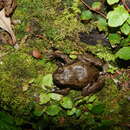Eupsophus roseus (Duméril & Bibron, 1841) è un anfibio anuro della famiglia Alsodidae.[2][3]
Etimologia
Descrizione
Biologia
Distribuzione e habitat
Endemica del Cile. Si trova tra Santiago a nord fino all'Arcipelago di Chonos a sud.[1]
Tassonomia
La specie presenta numerosi sinonimi:
-
Cystignathus roseus Duméril & Bibron, 1841
-
Borborocoetes bibronii Bell, 1843
-
Borborocoetes grayi Bell, 1843
-
Cystignathus sylvestris Tschudi, 1845
-
Cyclorhamphus fasciatus Peters, 1869
-
Borborocoetes pliciferus Werner, 1896
-
Cystignathus nigrita Philippi, 1902
-
Borborocoetes insularis var. ruber Philippi, 1902
-
Cystignathus pallidus Philippi, 1902
-
Cystignathus tympanicus Philippi, 1902
-
Cystignathus boedeckeri Philippi, 1902
-
Cystignathus oxyglossus Philippi, 1902
-
Cystignathus fernandezi Philippi, 1902
-
Cystignathus oreophilus Philippi, 1902
-
Leptodactylus kreffti Werner, 1904
-
Borborocoetes masareyi Roux, 1910
-
Paludicola marmorata Gorham, 1966[3]
Alcune specie del genere Eupsophus recentemente determinate (E. septentrionalis Ibarra et al., 2004,[4] E. nahuelbutensis Ortiz et al., 1992,[5] E. contulmoensis Ortiz et al., 1989[6]) sono poste come sinonimi di E. roseus da Correa-Quezada et al. nel 2017 in uno studio di analisi filogenetica sul genere[7], mentre uno studio successivo le considera specie valide[8].
Note
-
^ a b (EN) Alberto Veloso, Herman Núñez, Jose Núñez, Juan Carlos Ortiz 2010, Eupsophus roseus, su IUCN Red List of Threatened Species, Versione 2020.2, IUCN, 2020.
-
^ (FR) Duméril & Bibron, 1841: Erpétologie générale ou Histoire naturelle complète des reptiles. vol. 8, p. 1-792.
-
^ a b (EN) Frost D.R. et al., Eupsophus roseus, in Amphibian Species of the World: an Online Reference. Version 6.0, New York, American Museum of Natural History, 2014. URL consultato il 14 settembre 2017.
-
^ Ibarra-Vidal, H., J. C. Ortiz, and F. Torres-Pérez. 2004. Eupsophus septentrionalis n. sp., nueva especie de Leptodactylidae (Amphibia) de Chile central. Boletin de la Sociedad de Biología de Concepción 75: 91.
-
^ Ortiz, J. C., and H. Ibarra-Vidal. 1992. Una nueva especies de Leptodactylidae (Eupsophus) de la Cordillera de Nahuelbuta (Chile). Acta Zoologica Lilloana 41: 75–79.
-
^ Ortiz, J. C., H. Ibarra-Vidal, and J. R. Formas. 1989. A new species of Eupsophus (Anura: Leptodactylidae) from Contulmo, Nahuelbuta Range, southern Chile. Proceedings of the Biological Society of Washington 102: 1031–1035.
-
^ Correa-Quezada, C. L., D. Vásquez, C. Castro, A. Zúñiga-Reinoso, J. C. Ortiz, and R. E. Palma. 2017. Species delimitation in frogs from South American temperate forests: The case of Eupsophus, a taxonomically complex genus with high phenotypic variation. PLoS (Public Library of Science) One 12(8: e0181026): 1–21.
-
^ Suárez-Villota, E. Y., C. A. Quercia, V. Vera-Sovier, and J. J. Nuñez. 2018. Speciation in a biodiversity hotspot: Phylogenetic relationships, species delimitation, and divergence times of Patagonian ground frogs from the Eupsophus roseus group (Alsodidae). PLoS (Public Library of Science) One 13(12: e0204968): 1–19.


